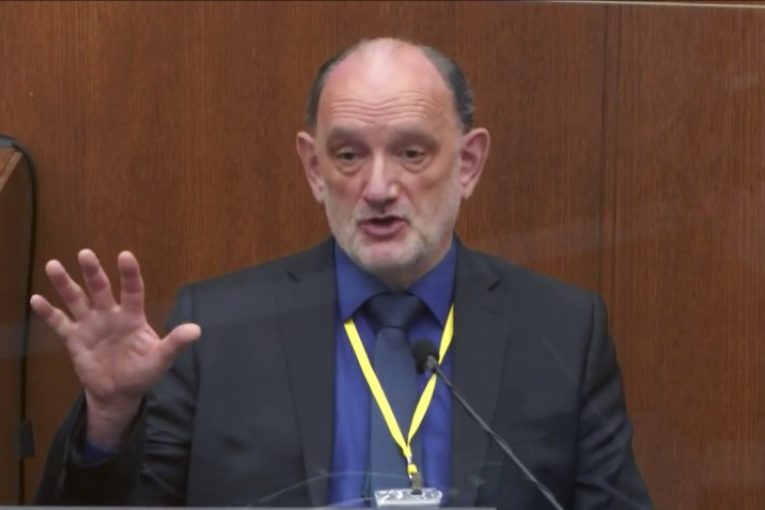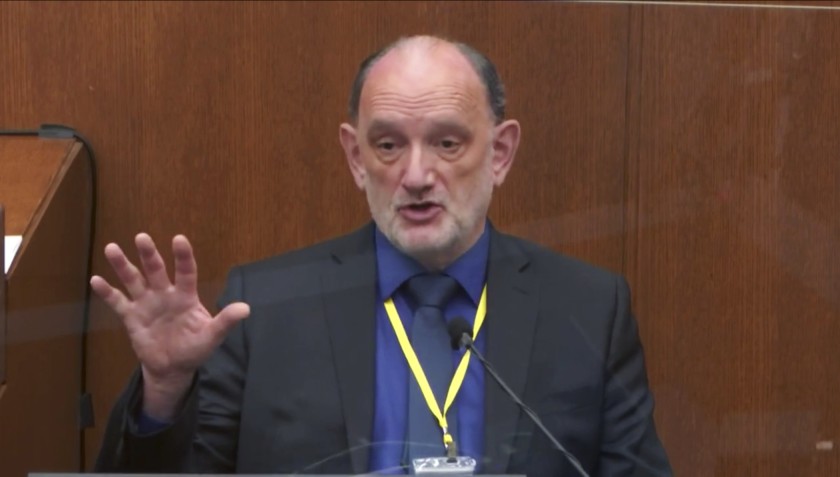

By Koda Slingluff and William McCurry
MINNEAPOLIS, MN – A defense expert began the Wednesday session with seemingly credible testimony that might benefit former police officer Derek Chauvin, now in Day 13 of his murder trial for killing George Floyd May 25, 2020.
But, by the end of the defense expert’s testimony, the prosecution had sowed doubt into almost every claim he made, including that Floyd may have had a pill in his mouth—but video evidence showed he was chewing gum
And, the defense said that it was carbon monoxide helped kill Floyd, not Chauvin’s knee on his neck cutting off the air supply for nearly 10 minutes.
The witness claimed that the cause of Floyd’s death was undetermined, and Special Prosecutor Jerry Blackwell charged the witness was intentionally misleading the jury.
The first and only witness called to the stand Wednesday was retired forensic pathologist, Dr. David Fowler, who worked at the office of the Chief Medical Examiner for the state of Maryland. While working at the office of the Chief Medical Examiner, they reviewed every homicide case. Fowler says that they reviewed, on average, 500-600 homicide cases every year.
In this particular case, there were 13 peer reviewers that were involved. Seven of them were forensic pathologists and Dr. Fowler said they were his “direct colleagues.”
The rest of the peer reviewers consisted of people who specialized in behavioral health, pulmonary pulmonologists, emergency room physicians, and toxicologists. Having many different peer reviewers with different specialties, it helped critique any opinion based on science, he said.
During a death investigation, Fowler stated that they have to gather all the information from the scene and gather past medical records. After this initial information is gathered they then look to other sources like ambulance run sheets, current and past medical information, witness reports, and videos that were taken.
Chauvin defense attorney Eric Nelson asked Fowler to speak about George Floyd’s death certificate.
According to Fowler, “the death certification process is one that is controlled and governed by the CDC.” The CDC guidelines split the death certificate into two parts: the primary cause of death and other significant conditions contributing to death, he explained.
As the primary reviewer in this case, Dr. Fowler made a PowerPoint presentation to “walk through” his opinions in this case for the forensics panel. “In my opinion, Mr. Floyd had a sudden  cardiac arrhythmia due to his orthostatic hypertensive heart disease during his restraint and subdual by police,” said Fowler.
cardiac arrhythmia due to his orthostatic hypertensive heart disease during his restraint and subdual by police,” said Fowler.
“His significant contributory conditions would be, since I’ve already put the heart disease in part one…the toxicology of the fentanyl and methamphetamine, there is exposure to a vehicle exhaust so potential carbon monoxide poisoning or at least an effect of carbon monoxide in his bloodstream and paraganglioma,” continues Fowler.
According to Dr. Fowler, Floyd’s heart was enlarged. Floyd’s heart was measured at 540 grams. Fowler spoke about the Mayo study, which was conducted in the U.S. by Dr. Mayo to measure the size of adult male hearts who have died. The Mayo study takes into account the height and weight of the male, and it tops out at 510 grams.
Dr. Fowler stated that when a heart is enlarged, its consumption of oxygen and other nutrients rises. If these needs are not met, “the heart will fail, have a sudden cardiac arrhythmia.”
In the heart, there are two major arteries; the left coronary artery and the right coronary artery. According to Fowler, there are certain drugs that cause the narrowing of these arteries. “In this particular case, methamphetamine which was present in Mr. Floyd has been associated with earlier onset of narrowing of the coronary arteries.”
In Floyd’s struggle with the officers, “it increases the demand and stress on the heart and the more the individual is stressed, both physically and in other ways, the more the demand on the heart is going to increase,” stated Fowler.
While Floyd was face down on the pavement with officers on his back, his face was directed toward the squad car near the tailpipes. Fowler determined where the vehicle was based on the fluid on the ground beneath it.
According to Fowler, carbon monoxide is an “extremely toxic gas” which Floyd would have been inhaling while near the tailpipes of the squad car.
In Fowler’s opinion, none of the vital structures of Floyd’s neck were impacted by Chauvin’s knee placement. Fowler then noted all of Floyd’s injuries were where Chauvin’s knee was not located.
“There was absolutely no evidence of any injury on the skin to the subcutaneous tissue or the deeper structures of the back or the neck,” he said.
Upon his review, Dr. Fowler eliminated asphyxia and hypoxia as a cause of Floyd’s death.
Fowler concluded the manner of George Floyd’s death as undetermined. An undetermined manner of death is a “classification that’s used when the information pointing to one manner of death is no more compelling than one or more other competing manners of death,” he said.
Prosecutor Blackwell began his cross-examination with a pointed line of questioning: Do you agree that an expert witness should be fair and impartial? You agree that as an expert witness you shouldn’t jump to conclusions, that is, you should reach fair conclusions after considerate analysis? You shouldn’t come at this from a position that’s biased? You shouldn’t cherry pick the facts?
In asking these questions Blackwell emphasized how Dr. Fowler’s testimony could mislead the jury. Not wanting to confuse the jury was a motif in the examination that followed. Blackwell worked to dispel factoids the doctor had presented as concrete.
Fowler had previously noted carbon monoxide poisoning could have contributed to Floyd’s death. His suggestion was based on Floyd being held down close to the exhaust pipe of the police vehicle.
Blackwell asked if Fowler had seen any data or test results showing that Floyd had any injury from carbon monoxide. Fowler had no data to reply with.
“For that matter, cutting even more to the chase, how do you know the car was even on?” Blackwell questioned.
The doctor responded, “It was a question I specifically asked, and then I made an observation of water dripping from what appears to be a tailpipe.”
Blackwell moved on quickly, referring to Fowler’s evaluation of carbon monoxide poisoning as an “assumption,” then talking about Fowler’s suggestion that Floyd had a pill in his mouth. Earlier Fowler had stated that the bodycam footage of Floyd being pulled over showed a white substance in his mouth which could have been a pill.
Blackwell showed Fowler footage from inside the store Floyd walked out of moments before the traffic stop. In the footage, Floyd moves his jaw and something white can be seen in his mouth. The motion of his jaw seems consistent with chewing gum.
“Would it be fair to say, in order to say that the substance in Mr. Floyd’s mouth was a pill, that would be jumping to a conclusion, wouldn’t it?” Blackwell asked.
Fowler did not answer directly, instead saying, “Specifically when I testified, I said there was a white object in his mouth. That’s all I could discern from that and I remember saying that under direct.”
Addressing Fowler’s beliefs that methamphetamine in his system and cardiac conditions contributed to Floyd’s death, Blackwell worked to discredit Fowler’s understanding.
He confirmed that Fowler does not have a degree in toxicology, is not a pulmonologist, or a respiratory physiologist (both of whom have testified for prosecution), is not a cardiologist, and does not effectively have the expertise to give more than an opinion on any drug or heart-related aspect of Floyd’s death.
Blackwell also got Fowler to admit that positional asphyxiation deaths generally do not have evidence of injury.
This was important to address Fowler’s earlier suggestion that there was no evidence of injury on Floyd’s neck. Blackwell set up the inquiry to show that no evidence of injury did not mean no injury, like the defense counsel suggested.
Nelson’s brief re-direct examination addressed some of Blackwell’s points, reaffirming the witness’s expertise and the presence of methamphetamine in Floyd’s autopsy.

To sign up for our new newsletter – Everyday Injustice – https://tinyurl.com/yyultcf9
Support our work – to become a sustaining at $5 – $10- $25 per month hit the link:






“In my opinion, Mr. Floyd had a sudden cardiac arrhythmia due to his orthostatic hypertensive heart disease during his restraint and subdual by police,” says Fowler.
I want to point out that this is pure speculation on the part of Fowler. At no time when Mr. Floyd was in police custody was any device capable of detecting an arrhythmia employed. The first application of such a device was by the paramedics and that “rhythm” was a flatline indicating no cardiac activity.
This and his testimony about the carbon monoxide were for the purpose of allowing him to claim that the death certificate assignment of homicide as the manner of death was inaccurate and that it should have been classified as “undetermined”. I disagree. Even if an arrhythmia had occurred, it would have been secondary to lack of oxygen due to the use of police force, whether appropriate or not. Same for any contribution of carbon monoxide which he would not have been exposed to had he not been held in that position for 9/12 minutes by police. Thus regardless of the terminal event, it would still have been homicide since all conditions were imposed by the police.
You are probably correct. However, the defense’s job is merely to obfuscate and create reasonable doubt in one juror. A low bar, particularly when the defendant is a cop.
So, here’s what I don’t understand (medically).
Isn’t our windpipe located closer to the front of our necks, vs. the side? I’ve tried applying pressure to the side, but it doesn’t seem to impact breathing at the level I’m applying pressure, at least.
Of course, I don’t have my knee on my neck, nor am I face down wearing handcuffs.
But if you strangle someone, don’t you have your hands around the front of the neck, constricting airflow? And, aren’t there tell-tale signs in the eyes (and neck for that matter), for someone who has been strangled?
Is strangled different than what’s claimed, here? Just “obstructed” enough, in this case?
If you’re able to say anything, doesn’t that indicate that some airflow is occurring? (But not necessarily the same thing as life-sustaining?)
In any case, those are the questions I might have, if my opinion made any difference.